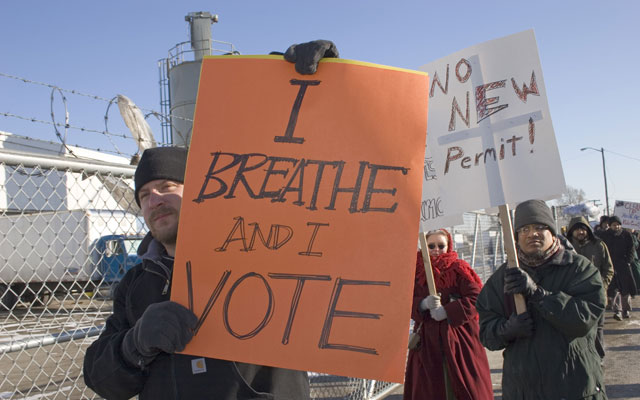Environmentalists Sue, Settle, and Apologize Later
Katie Tubb /

Protest was organized by the Hamtramck Environmental Action Team and supported by the Sierra Club. (Jim West/ZUMA Press/Newscom)
Environmental groups are the biggest abusers of a legal tactic known as “sue and settle,” according to a recent report from the U.S. Chamber of Commerce.
It works this way: An environmental advocacy group sues a federal agency—usually the Environmental Protection Agency (EPA) or Department of Interior—charging that the government hasn’t performed a duty it is legally required to perform. The agency then settles the lawsuit with the environmental group, allowing them to circumvent the notice and comment requirements that are built into the regulatory system. They then enter into a consent decree or settlement agreement, which is often enforceable by a court. By the time the public and regulated industries have any say in the matter, the details have already been determined.
Too often the result has been onerous regulations that satisfy an extreme agenda of an environmental special-interest group but seriously affect regulated parties who aren’t given a seat at the negotiating table.
Environmental groups brought at least 71 sue-and-settle lawsuits between 2009 and 2012. Thirty-four of those lawsuits were brought by the Sierra Club alone. They have resulted in over 100 new regulations from the EPA.
This system works nicely for government and special interests: Federal agencies appear forced into action by judicial fiat, but in fact the court’s order is more of a blessing to do what the special interests wanted to do in the first place but lacked the political means to do it.
But by not having the benefit of meaningful public scrutiny or stakeholder input, agencies develop new regulations that are poorly considered and lead to unnecessary costs imposed on the public and regulated communities.
This is exactly what happened with the EPA’s Utility MACT rule. In December 2008, several environmental groups sued the EPA for failing to regulate certain air pollutants from power plants. Without any participation from industry or the public, a judicially enforceable consent decree required the EPA to write and finalize a new rule by November 2011.
The EPA rushed out an expansive proposed rule that was chock full of errors, empty on technical support, and fuzzy on how companies were to comply. But at the end of 2011, the EPA published a final rule. As could have been expected given all the errors and vagueness, this final rule posed numerous problems for businesses and utilities, which essentially had no choice but to challenge the rule in court.
The abuses of sue-and-settle should serve as yet one more red flag that our environmental laws aren’t working for Americans. Instead, they are allowing the EPA to work around Americans in cahoots with radical environmental groups behind closed doors.
